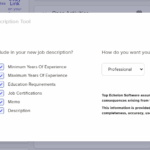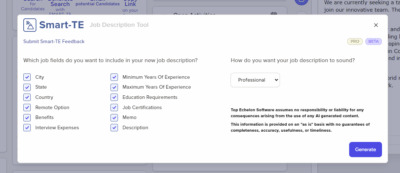Small businesses are the backbone of the economy, and their importance has been magnified in recent years. According to NerdWallet, small businesses helped create 10.5 million jobs between 2000 and 2019. In the face of increasing competition and shifting market conditions, small businesses need to ensure they are hiring the right talent to thrive. Hiring the wrong candidate or losing top talent can have far-reaching consequences for a small company that cannot afford high turnover or lost productivity.
In 2020, small businesses faced unprecedented challenges due to the global pandemic, with many struggling to stay afloat due to lockdowns and a decrease in organic revenue. However, despite the difficulties, there was a surge of entrepreneurial spirit, with 4.3 million business applications filed in the U.S. alone—the highest number in over a decade, according to the U.S. Census Bureau.
As small businesses continue to emerge and grow, recruiting the right talent becomes crucial to their survival and success. Finding, hiring, and retaining top employees can be a game-changer for small businesses, where each employee’s contribution is vital. One of the most effective tools available to help small businesses navigate this critical process is recruiting software, specifically Applicant Tracking Systems (ATS).
In this article from Top Echelon Recruiting Software, we will explore how recruiting software, especially ATS platforms, can benefit small businesses and streamline the hiring process. We’ll also dive into the key features an ATS offers that can transform your hiring efforts and improve your chances of building a winning team.
Why Recruiting Software is Essential for Small Businesses
Recruiting the right talent is a critical task for any business, but it is even more crucial for small businesses. Unlike large corporations, where a bad hire may be absorbed into a vast workforce, every hire at a small business makes a significant impact. A misstep in the hiring process could mean delays in critical projects, increased costs, or a hit to the company’s reputation.
With limited resources and time, small business owners often find it challenging to manage recruitment effectively. Recruiting software—particularly Applicant Tracking Systems (ATS)—can alleviate these challenges by automating key parts of the process, helping businesses find top talent faster and more efficiently.
Key Benefits of Recruiting Software for Small Businesses
- Streamlined Hiring Process: Recruiting software automates many of the tedious tasks associated with hiring, such as posting jobs, screening candidates, and tracking applicant progress.
- Improved Candidate Quality: With tools that help refine your search for top talent, recruiting software ensures that you attract and evaluate qualified candidates.
- Time and Cost Savings: By automating routine tasks and reducing the time spent manually managing recruitment, small businesses can allocate resources more effectively.
- Enhanced Communication: Built-in tools ensure seamless communication with candidates, reducing the risk of miscommunication or delays in the hiring process.
Now, let’s explore some of the specific ways that an ATS can help small businesses enhance their recruiting efforts.
1. Easy Job Boards and Job Posting
One of the biggest challenges small businesses face when hiring is getting their job listings in front of the right candidates. Large corporations may have the budget for extensive job board ads or recruitment campaigns, but smaller businesses often operate on limited budgets. That’s where the job posting capabilities of an ATS come into play.
Streamlining Job Posting Across Multiple Platforms
An ATS allows small businesses to post job openings across multiple job boards with just a few clicks. Rather than manually uploading job details to individual websites, an ATS can automate the process, helping you reach a wider audience. For example, many systems integrate with popular job boards like Indeed, Glassdoor, LinkedIn, and more, ensuring that your job listings are visible to qualified candidates.
Key Features of Job Board Integration:
- Free and Paid Job Postings: Some ATS platforms offer access to free job boards, while others allow you to post on premium job boards for a fee, giving you flexibility based on your budget.
- Customizable Job Boards: ATS software allows you to customize your own branded career portal, giving candidates a professional first impression of your business.
By expanding the reach of your job postings and saving time on manual uploads, an ATS helps small businesses attract a pool of highly qualified candidates—without breaking the bank.
Enhanced Sourcing Capabilities
In addition to job board posting, ATS platforms also streamline the sourcing process. Instead of spending countless hours searching for candidates on multiple platforms, an ATS allows you to conduct targeted searches across different networks, including LinkedIn and other social platforms, using a single interface.
2. Constant Communication: Keeping Candidates Engaged
In recruiting, communication is everything. Clear and consistent communication with candidates throughout the hiring process is essential to maintaining a positive candidate experience. When candidates feel neglected or uninformed, they may lose interest or view the company negatively, which can lead to missed opportunities for both parties.
Automating Communication for Efficiency
An ATS allows you to stay on top of your communications with candidates and clients by offering multiple communication options, such as:
- Email Integration: Automated email workflows enable recruiters to send updates, requests, and reminders to candidates at various stages of the hiring process. For example, you can automate confirmation emails for application submissions or schedule follow-up emails after interviews.
- SMS Texting: Many ATS platforms, like CATS, offer SMS integration, allowing recruiters to send text messages directly from the system. Given the high open rate of text messages (nearly 100%, according to marketing firm TxtSignal), this feature ensures that important messages reach candidates quickly.
Example Uses for Communication Automation:
- Interview Scheduling: Automatically send candidates invitations to schedule interviews using pre-set time slots.
- Application Status Updates: Keep candidates informed about where they stand in the hiring process, reducing uncertainty and frustration.
- Job Offer Notifications: Send personalized offer letters via email or text to successful candidates, expediting the final steps in the hiring process.
These communication tools not only keep candidates engaged but also enhance the overall candidate experience, making it more likely that your top choices will stay interested throughout the process.
3. Custom Workflows and Triggers: Tailoring the Hiring Process
Every business has its own unique hiring process, and small businesses often need flexibility in how they manage recruitment. With an ATS, you can create custom workflows and triggers to automate specific parts of the hiring process, tailoring it to your needs.
Creating Custom Workflows
Custom workflows allow you to define the specific steps that candidates will go through during the hiring process. This ensures that every candidate is evaluated consistently, while giving you the flexibility to adjust the process as needed.
Examples of Workflow Customization:
- Screening and Interviewing: Set up workflows that automatically move candidates from one stage to the next, such as moving from initial application review to phone screening and then to in-person interviews.
- Document Collection: Automate requests for necessary documents, such as references, portfolios, or certifications, during specific phases of the hiring process.
Using Triggers to Automate Routine Tasks
Triggers are automated actions that are activated based on specific events or criteria. For example, when a candidate reaches a certain stage in the hiring process, a trigger can automatically send them an email, change their application status, or notify the hiring team of the candidate’s progress.
Key Benefits of Triggers:
- Automate Administrative Tasks: Save time by automating repetitive tasks like sending interview confirmations, job offer emails, or reminders.
- Improve Efficiency: With triggers in place, the ATS ensures that no step in the process is overlooked or delayed, keeping the recruitment process moving forward smoothly.
Custom workflows and triggers enable small businesses to run a highly efficient and organized recruitment process, even with limited staff or resources.
4. Building a Talent Pool for the Future
Another major advantage of using an ATS is the ability to build a talent pool that can be tapped into for future job openings. Many small businesses struggle to fill positions quickly because they start from scratch each time a vacancy arises. However, with an ATS, you can keep a database of qualified candidates who have applied in the past but weren’t hired for a particular role.
Long-Term Benefits of a Talent Pool
- Reduced Time-to-Hire: By having a list of pre-qualified candidates, you can drastically reduce the time it takes to fill future roles.
- Engaged Candidates: An ATS allows you to maintain relationships with candidates in your database through regular communication, so they remain interested in your company when new opportunities arise.
- Nurturing Passive Candidates: With your ATS, you can keep passive candidates engaged by sending them company updates, job alerts, or industry insights, increasing the likelihood that they’ll apply when the time is right.
By building and maintaining a talent pool, small businesses can reduce the stress of scrambling to find new candidates every time a role needs to be filled, while also ensuring a more robust hiring pipeline.
Conclusion: Recruiting Software as a Key Tool for Small Business Success
In today’s competitive business environment, small businesses must do everything they can to attract and retain top talent. Recruiting software, particularly an Applicant Tracking System, can be a game-changer for small businesses looking to streamline their hiring processes, improve candidate quality, and build stronger teams.
From automating job postings and communication to creating custom workflows and building a talent pool, an ATS provides small businesses with the tools they need to compete with larger companies in attracting the best talent. By implementing recruiting software, small businesses can not only survive but thrive in the ever-evolving job market.
Investing in the right ATS platform can transform your hiring process, helping you save time, redu








